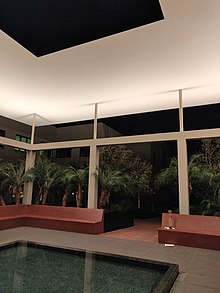
Light and Space denotes a loosely affiliated art movement related to op art, minimalism and geometric abstraction originating in Southern California in the 1960s and influenced by John McLaughlin.[1] It is characterized by a focus on perceptual phenomena, such as light, volume and scale, and the use of materials such as glass, neon, fluorescent lights, resin and cast acrylic, often forming installations conditioned by the work's surroundings. Whether by directing the flow of natural light, embedding artificial light within objects or architecture, or by playing with light through the use of transparent, translucent or reflective materials, Light and Space artists make the spectator's experience of light and other sensory phenomena under specific conditions the focus of their work.[2] From the movement's inception, artists were incorporating into their work the latest technologies of the Southern California-based engineering and aerospace industries to develop sensuous, light-filled objects.[3] Turrell, who has spread the movement worldwide, summed up its philosophy in saying, "We eat light, drink it in through our skins."[4]
- ^ Butterfield, Jan (1993). The Art of Light and Space. New York: Abbeville Press. ISBN 9781558592728.
- ^ Phenomenal: California Light, Space, Surface, September 25, 2011 - January 22, 2012 Museum of Contemporary Art San Diego, La Jolla.
- ^ Views and Visions: Exploring the California Landscape, March 1 - July 20, 2003 Archived May 18, 2013, at the Wayback Machine Orange County Museum of Art, Newport Beach.
- ^ Bruce Watson, Light: A Radiant History from Creation to the Quantum Age. Bloomsbury, 2016, p. xi.